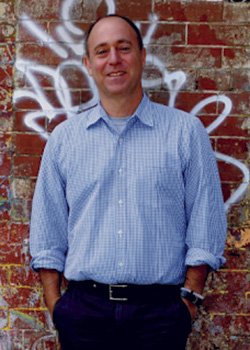With a 300,000-square-foot wood shop, metal fabrication and design studio — built on the mantra “Make Cool Sh*t” — James Geier has carved out an unusual niche.
He’s an industrial designer and sculptor that worked in kitchens, and owned and operated bars and event spaces in Chicago. His firm 555 International, founded in 1988, has designed and/or manufactured high-end retail spaces, venues for the Green Bay Packers and the Dallas Cowboys, and some of the hottest hotel and restaurant spaces in operation. Recently his firm worked on the renovation of Chicago’s Gemini Bistro and Goose Island’s microwbrew pub and restaurant.
What are the big trends in restaurant design right now?
JG: People are looking for a better experience, a more refined experience. I don’t mean traditional fine dining. For the last few years there’s been a backlash, and people have moved away from the white tablecloth experience. A few years ago, the burger became haute cuisine, and that has created a big shift in restaurants, in the food and the ambiance. Urban industrial as a style worked really well when pivoting away from finer dining experiences. People are looking for an elevated experienced in terms of materials, the environment, the overall design, the menus — they’re all getting more unique. The experience [of going out to a restaurant] is getting better and better.
What informs your design?
JG: It depends on how prepared the client is when they come to us. Sometimes they come along and have a very defined idea of their menu, their design, and they might have a very specific idea of the vibe they want. It’s not our job to emulate designs but to bring all the things together based on the soul, vibe, culture and menu concept the clients have intimated to us. Experienced owner/operators do that. But in a lot of cases they come to us and don’t have a defined concept. They might just have a space and know they have a customer for that space.
Who is their customer? What is the location? What is the reason for going to their location? We look at the customer base of the area and we work with the client to create a center, a core or a soul of what everything should speak to. From menu and branding to finishes and design: Who is that core customer and what is the soul of that space? That’s what informs our design.
What do you turn to for design inspiration?
JG: I read a lot of periodicals. I’m one of the old guard here, we’ve been in business a long time and I still get a lot of periodicals and magazines. Not just on interiors or design but cultural, world art. I’m an artist at heart, and I look at art and sculpture, and I travel a lot. I’m not always taking pictures but I’m really looking. I make a point of trying to seek out unique and interesting things no matter what areas I go to.
Every year I go to design week in Milan. It’s wonderful and inspiring for me. I make a point of going to all kinds of art events.
How did you get started in industrial design, and what led you to focus on hospitality?
JG: I’m an artist by birth and passion, a sculptor in particular. And I came up in and around the hotel and food and beverage industry. I started as a pool boy at 11 years old at the original Hyatt in Chicago and then became a lifeguard and pool manager. I spent time in the maintenance department, and I was an apprentice maintenance engineer before I started working in the kitchen. The executive chef took a liking to me, and I started working in the kitchen at all hours, on the line, peeling potatoes, you name it. And I started to get a sense that my future after high school was not in higher education but was in learning everything about the hospitality industry.
I was also working at a bakery in Chicago but thought my future was going to be in the executive chef training program at Hyatt. Then my mother made me quit my job and try college. My mother said, “Go to college for a year, and if you don’t like it do whatever you want.” So I did. And college led me to using my art, my engineering and design skills and honing my art skills into, ultimately, industrial design.
After the beginning of my professional career in design, I had the opportunity to build my first bar — to own and operate it — and we opened in 1988. I designed and built and owned and operated my first bar, Union, on the north side of Chicago. And I was already in the design building industry at that point, in retail environments. I started 555 on April 1, 1988.
I have been and still do to own and operate places in Chicago. Then I branched out from retail to do food and beverage and restaurant design for all kinds of people.
So, you found a way to blend your passions?
JG: A lot of our clients take advantage of the fact that I’ve been an operator and I understand the front of the house, the back of the house and all that stuff. That’s a really good and important part of what we bring to the table at 555. We have the knowledge of operations and how it all works and make sure that the design works with the operations and not against them.




